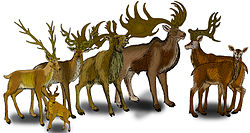Megaloceros
|
Megaloceros Temporal range: Late Pliocene to Late , 3–0.008 Ma |
|
|---|---|
 |
|
| Restoration of various Megaloceros and Praemegaceros species | |
| Scientific classification | |
| Kingdom: | Animalia |
| Phylum: | Chordata |
| Class: | Mammalia |
| Order: | Artiodactyla |
| Family: | Cervidae |
| Subfamily: | Cervinae |
| Genus: | †Megaloceros |
| Species | |
|
|
| Synonyms | |
|
Megaceros |
|
Megaceros
Megaloceros (from Greek: μεγαλος, megalos + κερας, keras, literally "Great Horn"; see also Lister [1987]) is an extinct genus of deer whose members lived throughout Eurasia from the late Pliocene to the Late and were important herbivores during the Ice Ages. The largest species, Megaloceros giganteus, vernacularly known as the "Irish Elk" or "Giant elk", is also the best known.
Most members of the genus were extremely large animals that favoured meadows or open woodlands, with most species averaging slightly below 2 metres at the withers. The various species of the Cretan genus Candiacervus – the smallest of which, C. rhopalophorus was just 65 cm high at the shoulder – are sometimes included in Megaloceros as a subgenus.
Despite its name, the Irish Elk was not related to the elk or wapiti but instead is closely related to the fallow deer genus Dama, and the genus was part of a Late Neogene Eurasian radiation of fallow deer relatives of which today only 2 taxa remain.(Lister et al. 2005, Hughes et al. 2006).
Although sometimes synonymized with Megaloceros, Praemegaceros and Megaceroides are apparently generically distinct.
...
Wikipedia
